#burgundian gown
Text
*pisses everyone off by writing/drawing the Northern Water Tribe as more Yup'ik and the Southern Water Tribe as more Inupiaq and refusing to acknowledge women's parkas with cinched in waists as canon*
#i'm sorry but i WILL NOT draw a hooded burgundian gown and call it an atigi#not in this life or the next#nor will you get pigeon-breasted tea dresses made of fur from me#eskimo on main#yes i know the yup'iit border the inupiat's southern territories. i do not care
72 notes
·
View notes
Text
Help needed!
Does anyone know how I delete necklaces off of meshes?

I've already edited the normal texture and the alpha one and this damn thing keeps showing up!
Tutorials thrown my way are appreciated, especially if they are videos.
#Sims 2#Ts2cc#Ts2#Simblr#I've got some banging burgundian gown recolours for when I finally get rid of that thing
2 notes
·
View notes
Text
I love the idea of rival factions at the Royal court with distinct styles of dress and I think one with untapped potential is the Great Council’s decision to choose the next heir aka Rhaenys vs Viserys.
One of Rhaenys’s greatest strengths is that she comes from three different houses so she would always represent House Targaryen, House Baratheon, and House Velaryon with her clothes. I think her primary colors would be red and gold in a Velaryon style of dress. Red for her dragon (Meleys the Red Queen) and for the Targaryens, and gold for the Baratheons and to show off her wealth. I think she would wear House Velaryon’s colors if she did not she need to assert herself as the Targaryen heir. Wearing a Velaryon styled gown she uses more subtle ways to align herself with the Velaryons. (See the hairstyle drawings for a better crown.)

Additionally, while she is feminine, she knows that Westeros is hesitant to elect a female ruler so she tone down her femininity. Therefore, no low cut dresses and nothing formfitting and nothing too colorful. I see Velaryon style dresses being based on Old Valyria (aka the Byzantine Empire) so a lot of shapeless dresses with a single stripe down the front and a v collar so this works in her favor. Sometimes she would layer these dresses with robes or long sleeves as well. This choice is also encouraged because she would not want to remind Jaehaerys and Alysanne about their relationship to their daughters. She emulates Jahaerys by wearing heavy fabrics, dark colors, dragon scale embroidery, and heavy jewelry like livery collars and crowns. Additionally, Rhaenys would definitely take hunting and dragon riding as an opportunity to network so she would have a whole wardrobe for outdoor activities. This wardrobe would be largely earthy tones to make herself seem more approachable to her hunting party. Again, nothing form fitting so she would wear bloomer style pants or have balloon sleeves. She takes out her copper armor during more serious or more formal occasions.
However, she wouldn’t want to be too masculine because Westeros is not ready for that either. She would wear take fashion cues from Alysanne and wear surcoats, braids, and flowing sleeves in the shape of dragon wings. Inspired by her mother, Rhaenys would wear flared dresses, gable hoods, bejeweled hair bands, and sarafan style sleeves. She would also have elaborate embroidery, statement necklines, a mantle- a long vest or cloak-, prints, and beading on her dresses as well since it’s Velyron fashion. Additionally, Rhaenys would wear elaborate and tall hairstyles with statement hair accessories. Most of these would have metals and gems collected from Corlys’s travels. Corlys would even commission a crown similar to the iron throne and Jae’s crown for her to wear on special occasions.



Rhaenys would always have an updo with a statement piece similar to a crown. Maybe she would wear her hair in braids with pins and rings adorning it for an added flare. Pearls would certainly be her main accessories but use gems from Corlys’s travels to adorn her headwear as well. I think hair nets like snoods and cauls would be popular on Driftmark since they resemble fishnets so she would wear them often as well. Also, since she’s under more scrutiny than others, she would make sure her hair is something that wouldn’t be easily disheveled. This is where her mother’s Stormland roots would come into play with tight braids and gable hoods.

Viserys’s strength is that he is a male heir with Targaryen features however I think he’s very clueless so he and Aemma would -play it safe and take their style inspiration from Jaehaerys and Alysanne. For Aemma, this would mean a similar color palettes, similar hairstyles, silver accents, and clothes designed form the same tailor. However, Aemma would put her own personal touch on that. For example, Aemma would wear Houppelande or Burgundian style gowns because a Vale fashion. I also imagine these would have lower necklines, and more lace details than Alysanne or Rhaenys as a way to appear more feminine. She would also wear soft colors and soft fabrics to appear more approachable to other members at court. Additionally, unlike Rhaenys, her jewelry would be sourced from across Westeros to give her a home land advantage. She would befriend ladies at the court by having favorite jewelers and tailors from each of their regions. After all, there is no better way to gain allies by showing you have personal interest in their homes.

For her hair, Aemma would almost always be wearing some sort of headpiece. A hennin and stickelchen for indoor occasions, designed by the same headdress designers as Alysanne, the Arryns, and the Hightowers. To support the Westeros economy of course. Also, if she’s feeling homesick, she has a hennin shaped like a crescent moon that represents the moon door in the Vale. She also has double or triple coned hennins to resemble dragon horns. If Viserys makes some sort of fauxpaus, she would wear a ridiculous headpiece so people would have something else to talk about. On other occasions, she would wear veils, hair nets, and metal headpieces similar to Old Valyrian styles. If her hair is ever visible, I think she would wear it either wear with ribbons, pins, or in bound braids like Alysanne.

Also building on her relationship with Viserys, she would wear things that would appeal to his interests. Since he is so interested in the histories, she wears a lot of Old Valyrian inspired clothing. Her sleeves are inspired by Valyrian architectures such as battlements. Her hennins sometimes resemble spires. Her bodice can resemble ceiling beams and neckline can resemble buttresses. If she’s wearing a dress with multiple colors, it would be inspired by stained glass. The stained glass could also resemble the Sept which appeals to followers of the Faith people as well. I imagine Viserys would’ve written her a poem or song about a long extinct flower from Valyria and how he would grow fields of them for her if he could. Which might showcase their relationship- he’s all about hypothetical gestures that appeal to his interests. But, it would work on her while she’s young so some of her dresses are the same color as that extinct flower.



#rhaenys targaryen#rhaenys the queen who never was#aemma arryn#aemma targaryen#asoiaf hair and clothing#valyrianscrolls#rhaenys velaryon#rhaenys x corlys#queen aemma#house of the dragon#hotd#viserys targaryen#corlys velaryon#corlys valeryon#fuck viserys#game of thrones#got#costumes#hotd fanart#asoiaf fanart#my art#mine
76 notes
·
View notes
Note
Just for fun: maybe a show of how both Aemma Arryn and Alicent Hightower would affect the court fashion by being from the Vale and Reach, respectably?
Oooh that sounds fun let’s do it!!
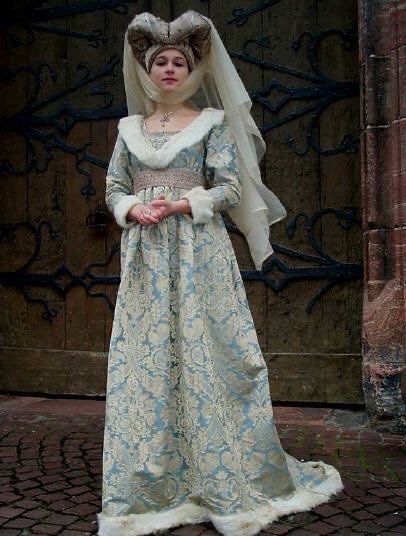

I believe in Burgundian dresses in the Vale supremacy. It just fits the vibe also fur!!! Very important no? Just overall a style that fits that elegant upper class vibe of the Eyrie before the dance, which Aemma grew up in. Big headdresses are the staple of every outfit, especially the hennin cone with a gauzy veil draped around. A very gentle, almost Virginia kind of fashion that Aemma grows up wearing and brings to Kings Landing when she becomes queen
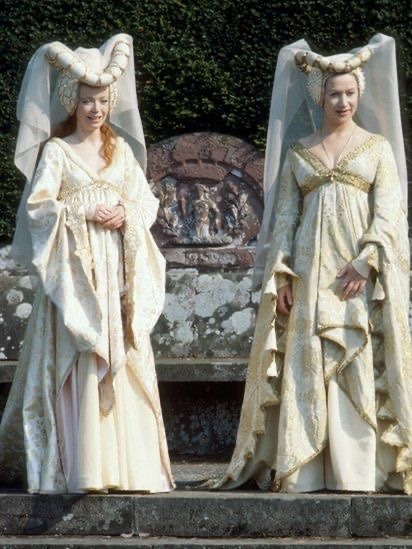
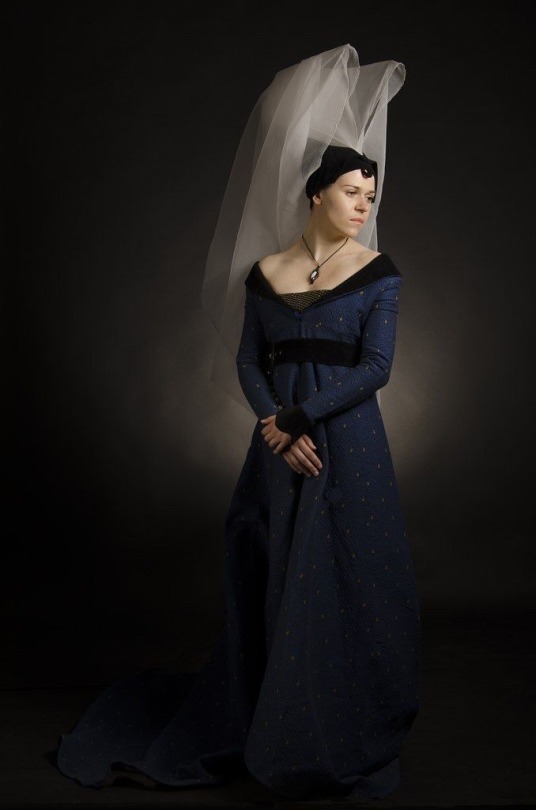
After a while in kings landing, this Eyrie fashion has adapted to the city. The basic cut of the gown is still the same, but seems to be a bit more complex and layered and sluttier. Ostentatious rich women take the idea of that elegant Eyrie fashion and just gild and glitz the shit out of it. OR a woman might downplay the gown and dress simply and just really heighten the look and size of the headdress, making it increasingly impractical (think the mid 1700s in France).


During Alicents early reign, she hasn’t garnered any influence or personal style yet and she’s still a young girl trying her best to get into the good graces of her old fart husband so she probably still resembles Aemma in her clothing. Modest and gentle without all of the grandiosity of the other women of kings landing, because of both the faith at Oldtown and her need to blend in as best she can. Eventually people start following in her footsteps, and more subdued and muted styles become popular, with a natural waist and bust coming back, as well as soft natural coloring
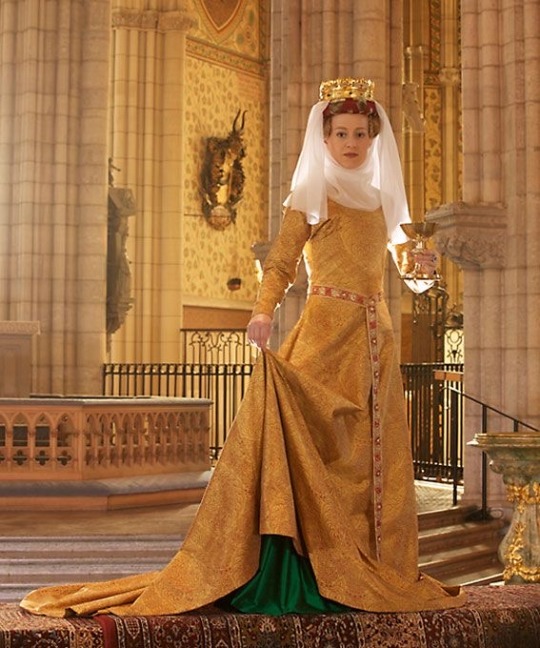

Once Alicent is firmly established, I think she starts to dress for piousness. Long sleeves that don’t billow out, skirts that cover everything and more, natural outline of the body, modest headdresses. And once the war begins this naturally starts to take hold throughout the city, as noblewomen go into mourning and also start to realize the excess they used to have cannot be afforded anymore.
#asoiaf#asoiaf hair and clothing#I know this kinda directly contradicts my fashion druring the dance ideas but#take it up with my lawyer#also yes I’m using show Alicent characterization here#you can also take that up with my lawyer
294 notes
·
View notes
Text

Lady Éloise of Penistone
I'll get to play Burning Wheel in August for the first time and am already incredibly excited. This is my PC's little sister that he absolutely hates.
Normally I don't really draw NPCs since I feel like that is more the GM's domain but my GM said medieval fantasy and when I asked how medieval said yes. So hennin and burgundian (inspired) gown it is and I asked if I could draw her.
Time permitting, I'll also draw portraits of the PCs, so look forward to that!
#My art#Fabi plays ttrpgs#Burning wheel#oc art#If you're curious about the name#It's pronounced pennystone#But my gm and I agreed it's funnier this way
21 notes
·
View notes
Text
So uhhh my headcanons on feminine clothing in the “main four” Westerosi regions in my mind, ie the four regions that are right next to each other with the majority of influence in the Seven Kingdoms and the most similar cultures. The Riverlands, Westerlands, Stormlands, and Reach. In my head they all wear various forms of clothing from roughly the late middle ages, with specific styles for each region


The Westerlands are a pretty basic Tudor shape. They’re all about ostentatious displays of wealth in every possible way, rich fabrics, rich jewels, time consuming constructions, etc. The flaunting of wealth extends even to things like wider sleeves that use up more fabric. In general, the idea is not just to show off, but also to sort of stand out against the landscape. With lots of flatlands, Westerland women prefer deeper, richer colors and textures. Plus it means not very much floral or nature motifs in fashion.


The Riverlands are similar to the Westerlands in silhouette as they are right next to each other, but are much more subdued when it comes to extravagant jewels. They’re a more down to earth culture, so narrower sleeves and modest necklines, more gloves and hats as you get further north. That being said, as they are practical people impracticality is their version of wealth flaunting - ie, clothing that is time consuming to make, costs a lot of fabric and material, and/or is difficult to wear and move in. Ruffs, even small ones, are a staple amongst all nobility. For their highest born ladies, especially on special occasions they’ll break out the French farthingale. And of course, the whackiest of shapes for headgear.
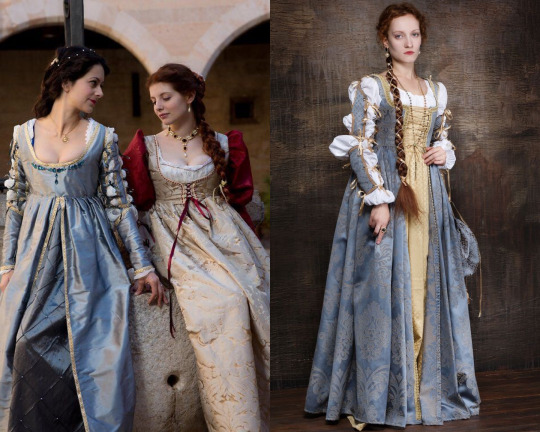

I envision that as you get further south in Westeros the clothing becomes less structured. The Reach is the epitome of the romanticized medieval period, where they believe in true knights and chivalry. Their clothes are all designed with a romantic aim in mind. The silhouette allows for a flattering structure no matter your body type, and the skirts get to flow freely around you. The Reach style is the epitome of fashion in Westeros, and it’s influences are being seen all over - even Cersei Lannister as queen occasionally veers away from her staunch loyalty to her homeland’s styles for the sake of staying fashionable and attractive. The Reach is a massive chunk of Westeros, so the border parts of the reach do bear similarities with styles from other regions. Go north and you’ll see some Westerlands decor elements on Reach silhouettes, go towards the Stormlands and the fabrics get thicker and more durable, more similar to houppelandes.

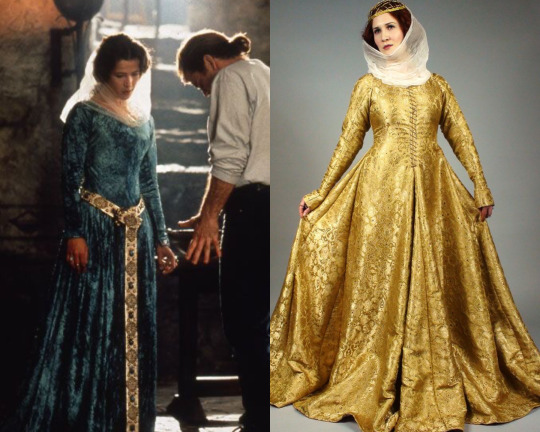
The Stormlands have been wearing the same styles for years and years, as they have less care for frivolities like fashion (so they say - they still very much like to dress wealthy). That’s only recently started to change, what with a Baratheon on the throne bringing an eye to their region for more than just their port trade. Less dress structure in the south, and a cage skirt like a farthingale is incredibly impractical in stormy weather. Instead, it’s a lot of layers of very heavy fabrics. Richer women show off with more and more expensive damasks and velvets, along with more fabric. Using more fabric than is necessary is the ultimate showing of wealth, and skirts being so long and heavy that the noblewomen have to actually carry them shows how little they have to work for that wealth. I think amongst younger people, Reach styles are starting to have an influence as they are right beside the Stormlands. Burgundian gowns have become all the rage, especially as you can add fur linings to it (both useful and showy in the windy Stormlands). In general more defined and higher waists are becoming much more commonly seen, especially once Renly married Margaery and his supporters in the Stormlands start to emulate her.
37 notes
·
View notes
Text

After months of trying to draft the sleeve myself, I'm resorting to tracing a sleeve that I know already works. Hopefully I can just resize it a little.
I have very little guilt because this designer was incredibly rude to my friend who was asking about buying a Burgundian gown last year.
5 notes
·
View notes
Text
FOR WANT OF A NAIL
@baldwin-montclair @adowobsessed @sylverdeclermont @nicki-mac-me @thereadersmuse @kynthiamoon @wheresthesunshinesblog @adowbaldwin @beautifulsoulsublime @lady-lazarus-declermont @adarafaelbarba-blog @dogblessyoutascha
Part Fifty-Eight
Summary: Baldwin Montclair had a string of ex girlfriends, a single child, and a lifetime longer than most people could dream of to make all kinds of mistakes. His family knew one which kept coming out of the woodwork to irritate him every other century
Also on AO3
It had been a busy three years. The English had taken Gascony, handing the French several brutal defeats. Reports of a horrifying disease sweeping through Europe from the Far East had scared people into the arms of the Church but the Great Pestilence had not yet reached France's shores.
In Brittany a fierce power struggle had erupted between the Counts of Blois and the Montforts of Brittany for the Duchy of Brittany. The Battle of Crécy had cost the French the port of Calais, introduced cannons to the world, and killed almost all leading French nobles.
Almost all. Yvette looked out across the entrance hall. As her father's second she had been cosying up to aristocracy her whole life but this was the first time she was expected to wine and dine in her own right. If tonight went wrong she'd be a laughing stock.
She resisted the urge to curl her hand tightly around the banister.
Everything has to be perfect.
'They are ready for you now, m'lady' Joan smiled proudly at her, hands clasped in front of her gown. Yvette took a deep breath, let it out slowly, settled her shoulders back and walked down the stairs.
She had picked a blue gown with slashed sleeves and silver-thread leaves curling across it, over a white chemise. A silver chain belt around her waist was also shaped like leaves. Her laced ankle-boots, cuff and collar were lined with gris, and she wore her hair up in braids threaded with ribbons sewn with pearls.
She descended and the chatter died away, all eyes upon her as she stopped towards the bottom of the stairs. She kept her arms by her sides, chin firmly raised, as she adressed the crowd.
'Welcome! Bless you all for coming,' Yvette was shouting in her mind, but she knew she was soft-spoken and she had to speak clearly and loudly if she wanted her voice to carry.
'It warms my heart that so many of you saw fit to accept my invitation. I know many of you have come a long way to be here tonight-' she locked eyes with Birger Dahlström, a diplomat from Sweden who had arrived in Burgundy to make friends, Gerbert De'Aurillac, and Dominico Michelle.
'-I hope we will provide such entertainment and stimulating conversation that you will not feel your time wasted. Please, be seated and feast!'
The polite applause buoyed her as she led the way to the great hall, the servants opening the door for her. Sweet-smelling wood burned in the braziers decorated with creeping ivy, and hung throughout the hall. A hundred coloured ribbons festooned the ceiling, with a hundred silver and glass stars hanging from them, glinting. Fountains of Burgundian wine sat at each corner of the room with glass ships sailing in them holding silver cups, and the tables had been laid with fresh flowers and silver tableware.
The important guests, and Yvette, were sitting on a raised dais at one end of the hall. At the opposite end was another stage where a group of musicians were playing gently.
'You are close, then?' Gerbert addressed Ysabeau as everyone settled into their seats. Ysabea, Gerbert and Birger were on Yvette's left; to her right, several ladies and lords who belonged to the local aristocracy were chatting among themselves, pointing in wonder at the ceiling and the fountains.
'Quite close,' Ysabeau smiled politely. 'It does not do to be unneighbourly.'
________________________________________________________________
Dinner was three courses. Venison and roast swan; roast pork, stew, and pastry custards, with roast boar's heads to decorate the tables and an elaborately-built castle, dyed red and made of marzipan.
More roast pork for the second course, along with glazed chicken, roast crane, heron and pheasant. A white soup, jelly stew, roast rabbits and jellied deer; tarts, fish, and another subtlety, this time in the shape of a green ship under full sail.
Yvette talked enthusiastically with Birger about the recent anti-slavery reforms introduced in the Kingdom of Sweden, and she was the first person to make the ambassador laugh.
Round three of the meal saw potage served, a sweet stew of almonds, honey and eggs, and a sweet syrup of honey, dates and wine. More roast venison, chickens, rabbits, and patridge, and roast pigeons, quail and larks. Pan puffs and jelly and long fritters were served last, and the final subtlety was the most elaborate, eliciting gasps and bursts of spontaneous applause.
Wheeled out on a cart to stand in the middle of the room was a metre-tall olive tree, its leaves drooping down in a cascade of dyed green, red, and blue. The whole thing had been carved from a single block of marzipan, and Yvette knew if had taken a small team of extremely pleased kitchen staff to make.
The musicians struck up a lively tune as the entertainment arrived. Jugglers and tumblers, fire-eaters and contortionists pranced and danced about, throwing colourful balls and balancing knives and each other back and and forth around the room.
The tree was wheeled away and the trestle tables removed, the tumblers moved to various points around the room and the guests took to the floor to dance. In an act of equitability Yvette shared the first dance with the rest of the high table; the group swayed along gently in a ronde, Yvette singing and the others answering with the appropriate refrain.
The circle melted away into quadrilles as the rest of the guests flocked onto the dance floor. Yvette danced with Gerbert, Ysabeau watching carefully from the perimeter; Domenico slipped in gracefully as soon as the music ended and Yvette danced with him as everyone parted again and reformed as pairs.
Yvette made sure to dance with every single one of her guests and by the end of the night she was happy and exhausted. The servants brought the roof down, literally, and Yvette snipped silver-glass stars free from the ribbons and handed them to the guests as they headed off to bed.
Yvette slipped out of her shoes and walked barefoot back to her room, Joan keeping her balanced with an arm around her waist and a hand on her elbow as they climbed the stairs together.
As she helped Yvette get ready for bed, washing the makeup from her face and brushed her hair, Joan squeezed her around the shoulders in a tight hug.
'Tonight was a triumph!'
Author's Notes
There was a LOT happening between 1345 to 1347. If I spell it out in the notes we'll need a whole other chapter but just know, there was A LOT.
The Black Death won't be called that until 1755, by the Dutch. Originally it was called a pestilence, an epidemic or a mortality. Its "titles", for want of a better word, included "The Pestilence", "The Great Pestilence", "The Plague" or "The Great Death". It did reach France in 1347 but this chapter takes place in January and the plague won't reach French shores until November.
Gris: the gray back fur from European red squirrels that was a common high-end fur used to line the clothing of nobility during the medieval period
Pearls were used as good luck charms during the Middle Ages; specifically, it was believed that they granted protection during battle
Medieval drinking fountains were a thing! They worked via air pressure in the pipes forcing water up from a hidden reservoir. And there ARE records of wine fountains! For example, allegedly it was traditional for London fountains to flow with wine instead of water upon the coronation of a new king (although it's unclear how that was achieved) and there is a wine fountain in Caldari di Ortona, in the Abruzzo region of central Italy.
Pewter alloy was the Royal Doulton of medieval tableware. Poorer families used wooden bowls if they could afford them or make them, or "trenchers", hollowed out bowls made of bread. Middle class families used pewter if they could afford it, and the wealthy used silver and, in some cases, gold.
The meal is allegedly an actual banquet King Richard II gave for the Duke of Lancaster (because I'm lazy and didn't want to menu plan)
If you've ever seen a half-way accurate medieval feast in a movie, you've probably seen an elaborate sculpture sitting on a table or being paraded around by servants. That's a subtlety. They were elaborate sculptures made of food (and not food, as they gained special significance in the late middle ages), and shaped into symbols that represented the "theme" of the feast.
I chose a castle for protection, a ship under full sail for wealth and prosperity, and an olive tree for peace.
Red - colour of love
Green - wealth, prosperity, youth
Blue - purity, peace
Yes, Sweden did have a slave trade! "Thralls" were taken from Eastern Europe or the British Isles; slaves were typically Franks, Anglo-Saxons, Celts, Baltic, Slavic and Latin. Occasionally they also bought and sold Byzantine or Islamic persons. Although "thralldom" was officially outlawed in 1335 by Magnus IV of Sweden, slavery continued outside the borders of Sweden, in Swedish territories abroad, until the 17th century.
A Carole or Ronde is a medieval dance involving a group of people in a chain or a circle, with one person singing a song and the rest of the group singing a refrain. A quadrille is dance for four partners standing together in a square, and a basse dance is a slow dance for two partners.
#baldwin montclair#baldwin de clermont#bibaldwin#baldwin montclair/male oc#adow#a discovery of witches#all souls trilogy#all souls series#a discovery of witches season 1#a discovery of witches season 2#a discovery of witches season 3
3 notes
·
View notes
Note
Do you have specific fashions you attribute to/associate with a region or house in asoiaf?
I have to admit I'm not very consistent in my tumblr illustrations about this but ...
In general, my absolute preference for fashion in Westeros is 14th / 15th century Europe. If I had to decide, I would bring Houppelande back into fashion, I love it. Burgundian gowns too.
In a more reasoned way, I like to associate "Viking" fashion with the Ironborn for obvious cultural similarities. Another association that I like and maybe I should investigate more is that between the North and Kievan Rus'. For Dorne I love the Byzantine influence.
Another thing that I often let myself be influenced by in the taste of clothes is Italian art from the late Middle Ages to the early Renaissance. The Reach should be Florence and Braavos the Venice of the doges.
I don't have a too structured idea about it, I often keep elements that convince me and I ignore those that don't. Sometimes I use models that exist, but I make the characters wear them in an unconventional way or by choosing a decorative pattern that is not philologically correct. I often use fabric buttons, detachable sleeves, layered dresses, poulains, brooches, fur trims for example.
The thing that matters to me more than historical correctness is that the dress communicates something about the character. I like to try new ways to put sigils in the clothes.
I avoid references to Clapton like the plague because I don't agree with many of her choices and I want to get away from the imagery of the TV series. And I also try to avoid some clichés of the fantasy aesthetic because it is very easy to expire in the discounted version of Tolkien and I don't think it goes well with the mood of Asoiaf.
Having said that, I always accept input and advice regarding these things. Thanks for asking!
55 notes
·
View notes
Text
Dear @sanguinarysanguinity, I received your questions for the ask game, but Tumblr was being mean about letting me post my full reply, so I will try again in this format:
7. Favourite historical dressing, uniform, or costume?
Hm, there are several eras of (fashion-)history that appeal to me.
For men's fashion, I think the mid- to later 18th century is particularly pleasing to the eye (think 1750s to late 1780s).
As for women's fashion, I have similar sentiments, with an added love for later 15th century Burgundian fashion and baroque court gowns of the late 17th/early 18th century.
A particular type of clothes that I find interesting is the riding habit, and how for the longest time, it was styled similarly to menswear. Not only do I simply like the look, I enjoy reading about how people, especially men, reacted to these outfits. Some genuinely felt threatened or offended by women donning clothes cut in a similar fashion to and inspired by male attire (and in cases of the late 17th/early 18th century, also men's wigs).
I am fascinated by them, and the societal implications of (upper class, it has to be said) women adapting men's clothes to a) functional sportswear and b) a fashion statement that ruffled quite a few conservative feathers and pushed the boundaries of strictly gendered clothing.
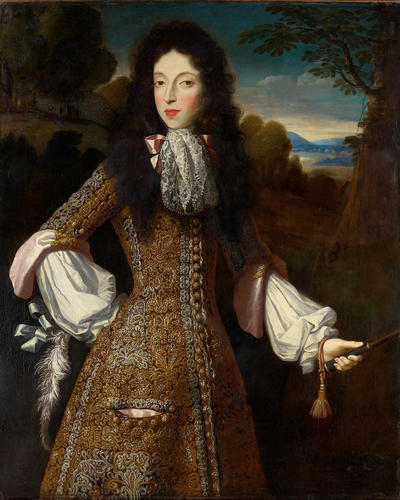
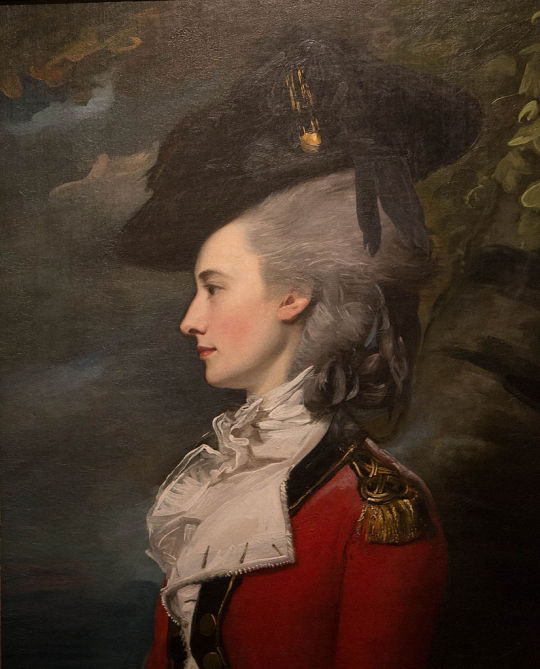
Different eras (1670s and c. later 1770s- early 1780s), but these are both looks.
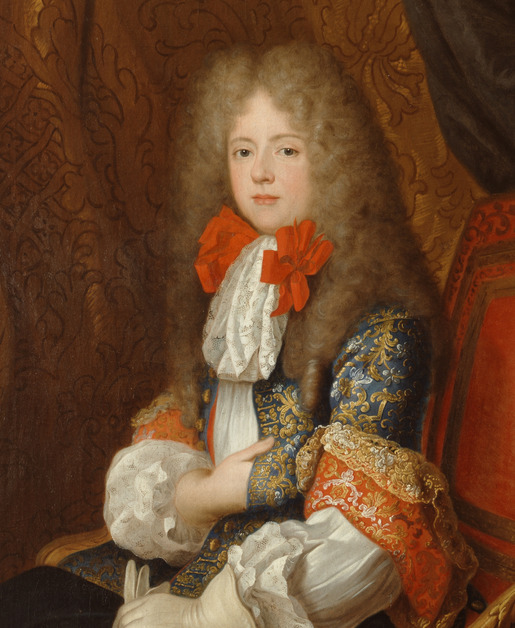
The sitter is quite famous and has featured a couple of times on my blog; though with the hint of skirts showing below the broad-brimmed, plumed hat cut off, it suddenly grows way harder to tell at first glance whether the person in the allonge wig and lace jabot is a man or a woman.
I do however sometimes dress up as a regency lady, so there's that, too. Not my all-time favourite era of (sartorial) history, but one that it was easy getting into costuming and finding events for even as a beginner.
8. What is the last thing you have read, listened to, or spoken of with historical reference?
I read a slew of ads on used book sites to finally get my hand on 1910s physical copies of Marjorie Bowen's William of Orange triology. Not very popular around these parts, it seems, alas.
I have also tried and failed to get my hands on D. K. Broster's Jacobite triology, with a similar success rate.
9. Favourite historical film?
Depending on the mood, it's either Master and Commander, or Persuasion (the 1995 film; we don't talk about the most recent adaption). Both stand out to me for the attempt at realism in trying to depict the period, the story, and great set and casting.
I do however also love the not as historically faithful Le Roi Danse, which is one of my go-to comfort movies, and Das Boot (1981, not the soulless 2018 series), which will always hold a special place in my heart for having been the first piece of media set in a historical context that I recall having consumed, and which I suspect was the gateway to an interest in naval warfare that at last led me to where I am now- having an almost forgotten admiral of the American Revolutionary War as my blog icon (sorry to everyone who thought that's me! ;)).
11 notes
·
View notes
Text
Young Henri de Guise
Born at Joinville on New Year's Eve, 1549, the life of Henri, third Duke of Guise, was forever scarred by one harrowing event. At the age of twelve he had been forced to watch his father die in agony. The letters he wrote as a 7 year-old to the father, who was away on campaign, reveal a precocious intelligence. Henri idolized his father. When his uncle suggested that he would make a good priest he wrote to his father: "I would rather be next to you breaking a lance or a sword on some brave Spaniard or Burgundian to show that I like much better to fence and joust than to be always shut up in an abbey dressed in a gown." His formal education was, however, brief. At the age of 7 he was sent to Navarre College with the two other Henris, who would one day be his rivals: Henri, the son of Antoine, King of Navarre, and Henri, Duke of Anjou. But it was barely a year before the Prince of Joinville, as he was styled, was summoned by his father to learn the profession of arms. He was soon joined by his younger brother, Charles (born in 1554), while his youngest brother Louis, born in 1555, was destined to inherit his uncle's ecclesiastical empire. Henri was not interested in letters and, in spite of the close attention of his uncle and his grandmother, his knowledge of matters theological was superficial: "I heard the beautiful sermons that my uncle gave at Reims but I promise you," he wrote to his father, "that I will not be about to recite them because they were so long I can only remember half of them." Like his father and grandfather, he was more interested in traditional aristocratic pursuits and his letters resound with the theme of horses, hunting, and war.
In an age when looks and demeanour were thought to herald majesty, the beauty of the House of Guise was renowned. It contrasted with the ugliness that afflicted most of their Habsburg, Valois and Bourbon contemporaries. And the portraits of the new duke support the contention of observers that Henri —as ‘beautiful as an angel’, according to the Venetian ambassador —surpassed even his cousin, Mary Stuart, in looks. He had the trademark pale visage and curly, strawberry blond hair. He was tall too and had a good physique shaped by the usual martial sports and tennis and, more unusually, swimming —he could, it was said, swim across a river in
armour. He inherited both his father’s charm and common touch: his immense attractiveness to women and affability with commoners would later be major political assets. If Henri had an Achilles heel it was hubris. In his father, the inbred pride of the aristocrat had been
tempered by reserve and modesty, which charmed even his enemies. Henri, in contrast, inherited some of his uncle’s arrogance. A story told by Marguerite de Valois about the young duke is instructive. Asked by her father, Henry II, which prince she preferred, Guise or the Marquis of Beaupréau, son of the Prince of la Roche-sur-Yon, she agreed that Guise was without doubt the better looking but she preferred the other because ‘every day the duke does something bad to someone and always wants to be master’. The story is probably apocryphal but it stood the test of time because it captured something essential.
Stuart Carroll- Martyrs and Murderers: the Guise Family and the Making of Europe
#xvi#stuart carroll#martyrs and murderers: the guise family and the making of europe#henri i de guise#house of guise#françois de guise#henri iii#henri iv#marie stuart#marguerite de france#la reine margot#henri ii
6 notes
·
View notes
Text
I had a dream last night where I was wearing a velvet house coat that looked a lot like a burgundian gown. The urge to go completely off my sewing plans and making this instead is palpable.
3 notes
·
View notes
Text

Reasons why Steph should be exempt from sumptuary laws 1/93828182828 (Cass will hear them all)
[id: Cass and Steph walking together. Cass is wearing a burgundian gown and a balzo headdress with crespines and a veil. Steph is wearing a kirtle, a wimple, and a pouch. The image is in flat color.]
4 notes
·
View notes
Text
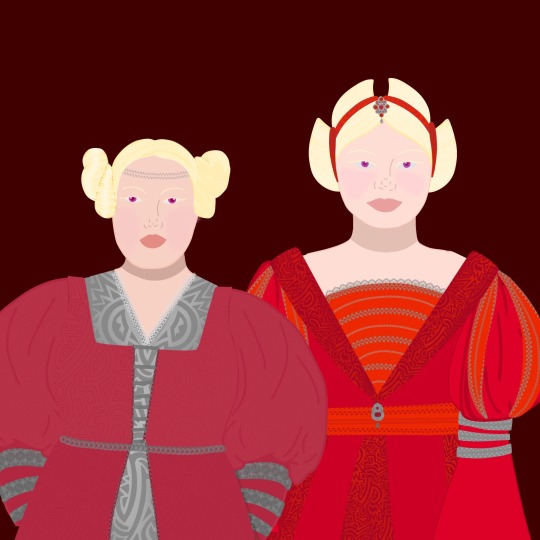
🦀Prunella and Prudence Celtigar🦀
These two minor characters are the only named women of House Celtigar, one of the three houses of Valyrian descent so naturally they caught my attention. Given the Valyrian supremacy of the other two houses, none of them married a Celtigar? Very strange.
Prudence appears to be the eldest sister since she got married first in 52 AC to Lord Grafton in the Vale. She also seems the braver of the two as she was stabbed by Septas while protecting Alysanne at Joquil’s Pool. Her dress is inspired by Burgundian gowns and her hairstyle is based on Ukiyo-e hairstyles from Japan’s Edo Period.
Prunella is likely the younger sister. She was married in 55 AC to Lord Peake in the Reach. This was recorded as an ‘exceptional match’ so the two were most likely in love. Her dress is inspired by the Italian Renaissance and her hair is inspired by the squash blossom hairstyle of the Hopi women.
#house celtigar#prudence celtigar#prunella celtigar#asoiaf fanart#asoiaf#HOTD#house of the dragon#game of thrones#Valyrian#house targaryen#house velaryon#vale#reach#house grafton#house peake#alysanne targaryen
64 notes
·
View notes
Text
like there really is a thin line between believability and Cool Designs and i feel like game of thrones as a show manages to toe that line very very very well???? genuinely the thing that got me into concept art and costumes was the show
and there's a lot of discussion online from ppl that think it should veer more to one side for realism or to another bc "it's fantasy so whatever" and it really is one of those things that helps ground not only you as the viewer to the world and characters but also the actors who are actually wearing the thing


the difference between a costume that could be a little better if it was more historically "accurate" and a costume that doesn't need to be bc it fits the setting is very clear when you're watching the thing
the answer isn't necessarily more "accurateness"!! the one on the left is actually probably really close to an actual burgundian gown but it's just like kinda shittily done? the only reason you can tell it's cheap polyester is that it's distracting you from the world and whats going onnnn



imo easily made better by making the neckline be just a little lower but my points made i think
0 notes
Text
Partlet

A 16th century fashion accessory. The partlet was a sleeveless garment worn over the neck and shoulders, either worn over a dress or worn to fill in a low neckline. The earliest partlets appeared in late 15th century fashion. They were made of silk or linen, and were worn to fill in the low necklines of both men’s and women’s Burgundian dress. Early 16th century partlets were made in a variety of fabrics and colors, although black was most popular. Black partlets worn over the gown, usually in velvet or satin for the upper classes, are an earlier style. Fine partlets made of linen lawn, with standing collars and ruffles, could be worn directly over a low-necked smock, or over the kirtle. Elaborate lattice-work partlets were decorated with gold and jewels or pearls. This was called “Caulle fashion” in England.
0 notes